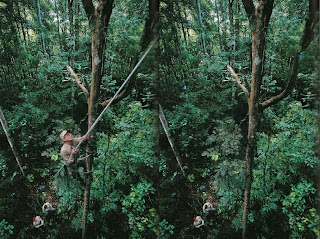One of my favorite images from the erasure project is the one from the National Geographic, October 1998 with the man in the middle of the forest up the tree. At first I was going to take out the tree and have him floating there but I realized I kind of did that for the woman on the mountain so I decided I should just take out the guy and his pole instead.
I thought removing the guy and the pole wouldn’t be too hard but I was sadly mistaken. I used the clone stamp for this entire process, cloning every little leaf I could find and meshing them together over the man’s figure to make a very convincing bush. I would normally use the blend tool to help but with the leaves being so distinct I didn’t want to risk it looking like I obviously removed something that was clearly on top of the bush. I’m glad with the final result of that picture because I showed it to my friend and she didn’t know what was missing from the picture before she saw the original.
For all the images in the erasure project I used the clone stamp quite frequently. It is a very useful tool in removing something but still wanting the original background to be there. I used the blend and healing pen a lot on the image of the guy putting up the missing phone number posters. I also used it a lot in the mountain climber in the clouds picture. Other then that it was mainly the clone stamp tool throughout all the images.
I believe I did when it came to the finer details. I’m very OCD and I didn’t want any of the images to look as if something was obviously taken out if you hadn’t already seen the original. I made sure to make everything perfect. I don’t know if that counts as a critical perceptive, but I did critique myself until it was perfect.












